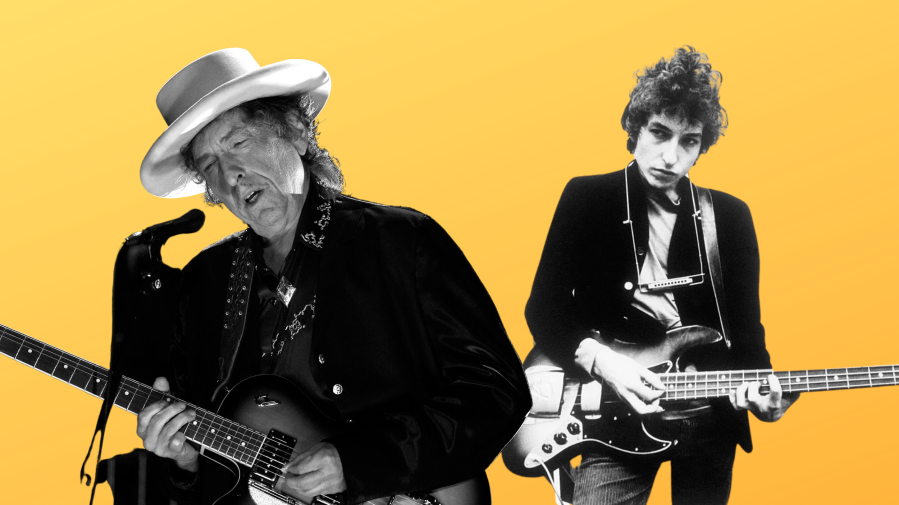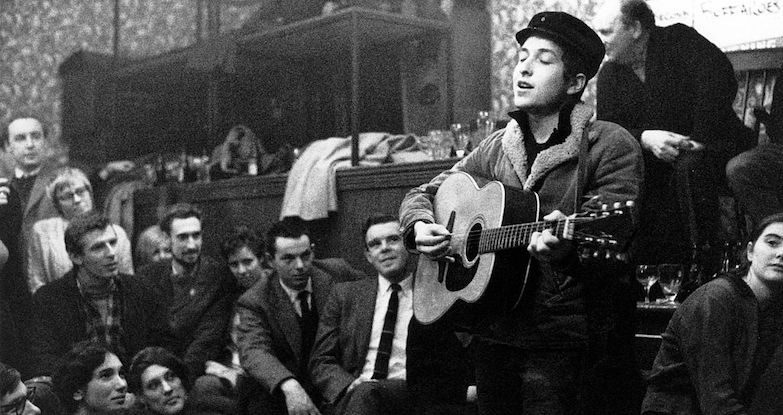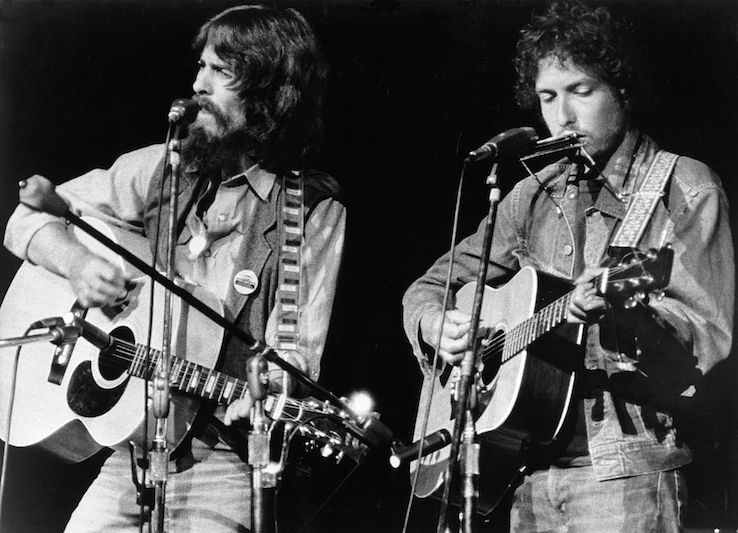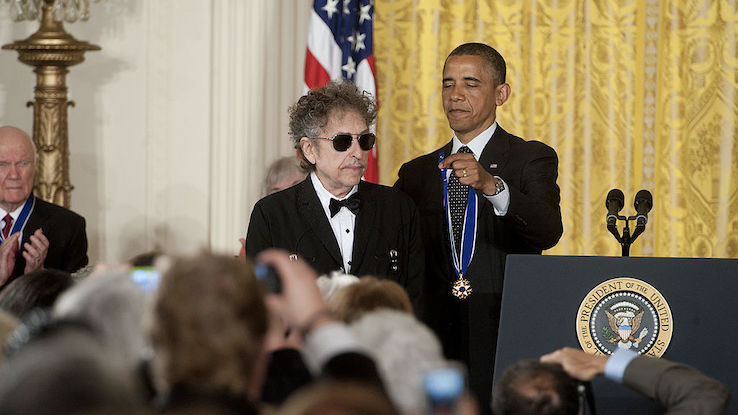Why Did Bob Bekel Leave the Five Again

Bob Dylan is often referred to equally the vocalisation of a generation. Throughout his career, which has spanned more than one-half a century, his lyrics accept touched the hearts of millions. And his bear upon on the musical landscape has only get more undeniable. March 19 marks 60 years since the release of his starting time album, the eponymous Bob Dylan, and he'south even so enchanting audiences with his "freewheelin'" performances and the independent perspective that's divers his body of work.
This icon has lived many lives in his decades-long career, and Dylan truly does "incorporate multitudes," as expressed on his 2020 studio album Rough and Rowdy Means. Throughout his many reincarnations, he'southward also remained a symbol of spirited provocation. From bringing awareness to injustice around the world to encouraging people to await beyond themselves in the turbulent 1960s and today, Dylan continues to evangelize authenticity and invite curiosity on tour and at residuum. In commemoration of these and other notable contributions he'south made to the worlds of music, civil rights, politics and even morality itself, we're taking a wait at The Bard'due south indelible legacy.
Dylan's Humble Beginnings Led Him to the Big Apple

Born Robert Allen Zimmerman in 1941, Dylan'south love affair with music began during his babyhood in Minnesota. Early, legendary artists like Fiddling Richard, Hank Williams and Woody Guthrie captured young Dylan's attention and led him to explore music more seriously. Throughout high school, he played with diverse bands, performing covers of Elvis and Trivial Richard songs while honing his skills on the guitar and pianoforte.
In 1959, while studying at the University of Minnesota, he started to introduce himself as Bob Dylan, a name he chose afterwards discovering works past the Welsh poet Dylan Thomas. By 1960 he'd become fully invested in learning more than about Shell poetry and folk music, so he left schoolhouse to pursue a new life in New York City — and hopefully connect with his ailing idol, Woody Guthrie, who was hospitalized nearby in New Jersey.
Like many young artists, Bob Dylan was inspired by the rich civilization of New York and began to connect with other musicians while developing his ain style. Later settling in the city, he started performing at folk clubs in the Greenwich Village neighborhood and was eventually spotted by a talent picket who signed him to Columbia Records.
In 1962 he released his debut self-titled album, which drew largely from the many influences he'd encountered up to that betoken. Unfortunately, information technology wasn't a commercial success — but it was an important stepping stone. His 2nd record, 1963'sThe Freewheelin' Bob Dylan, was where his vocalization truly emerged, and information technology would be this album that started to solidify his presence as a protest vocaliser fighting for change. Long before the days of social media sensation campaigns, Dylan had begun to cast a glaring light on private instances of injustice and racist violence while providing a soundtrack for a populace committed to changing the condition quo.

Bob Dylan boldly stood against oppression as an individual and an creative person, and this reputation defined much of his career. Through anti-war anthems like "Masters of War" and provocative inquiries like "Blowin' in the Current of air," Dylan cemented himself as a thoughtful songwriter who refused to shy away from controversy. He performed at the 1963 March on Washington, and though he has never been interested in audience reverence for his positions on moral topics, his involvement in anti-war protests and the Civil Rights Movement helped to move the needle toward progress. "You couldn't help merely feel the wheel of history turning," Peter Koper, who saw Dylan perform live at the March on Washington, told The New York Times.
Always an innovator, Bob Dylan too inverse the landscape of folk music in improver to challenging the establishment. His early on rock influences and tendency toward innovation led him to create music that expanded the folk genre. In only one example, his experimentation with the electric guitar in 1965 was met with a mixed reception by the Newport Folk Festival crowd. Just that didn't end him from pushing boundaries and creating music that authentically represents who he may exist at any given moment, "whoever that is."
The Artist Remains a Living Legend

Though he famously rejected the title of poet — "I think of myself more equally a song and dance man, y'know," he once told reporters at a press briefing — and initially even rejected his Nobel Prize for Literature, his artistry seemingly knows no premises. In addition to winning countless Grammy awards, this ever-evolving artistic force is also an accomplished visual artist. Some of his pieces, which range from paintings to sculptures, can exist constitute on his personal website; The Guardian's Jonathan Jones has described them as "evocative celebrations of life itself." The largest collection of his drawings, paintings and sculptures to engagement, totaling over 100 original works, tin can exist constitute at the Patricia & Phillip Frost Museum in Miami, Florida.
Since his kickoff tape debuted six decades ago, Bob Dylan has released almost 40 albums and shows no signs of hanging up his guitar. And he's not just a musical legend. Though he is a well-decorated musician with such accolades as a Presidential Medal of Freedom, a Nobel Prize and endless other high honors, he'south not defined by awards or his reputation. He continues to unfold and discover himself, fifty-fifty as the 60th ceremony of his fourth dimension in the spotlight passes.
Bob Dylan truly embodies the idea of "loving the art in yourself, not yourself in the art" championed by the famed theater artist Konstantin Stanislavski. His willingness to explore new artistic ideas and embrace curiosity — and even chaos — highlights the ability of the impulse to create, while his personal convictions gloat the brilliance and dazzler of everyday people. As he continues his Never Ending Tour — which began in June of 1988 — we'll keep waiting to come across what "complete unknowns" Dylan surprises us with side by side.
Source: https://www.ask.com/entertainment/bob-dylan-album-anniversary?utm_content=params%3Ao%3D740004%26ad%3DdirN%26qo%3DserpIndex
Post a Comment for "Why Did Bob Bekel Leave the Five Again"